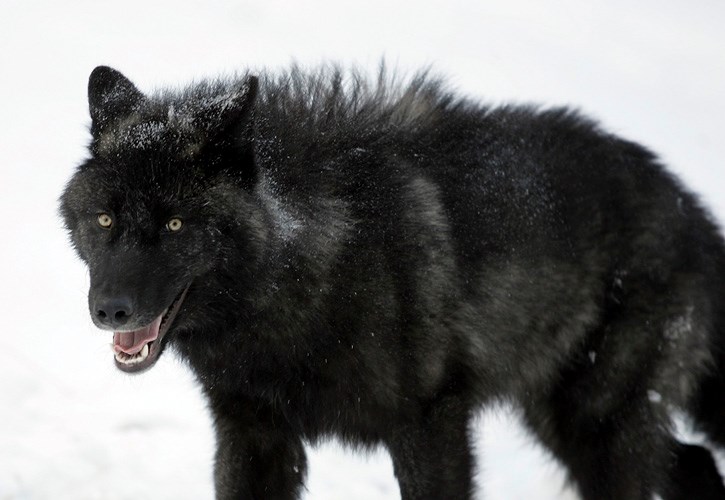Wolf activity increased slightly this winter around the periphery of Canmore where a wary Banff wolf pack has been travelling and hunting.
The Fairholme wolf pack is seldom seen, but remote cameras in Canmore and GPS collar data from Parks Canada show the pack made a few more forays into Canmore this winter than it had before.
“They’ve been out a few times on both sides of the valley, and have killed a few animals,” said John Paczkowski, a wildlife biologist with Alberta Environment and Parks.
“I think they’ve figured out there’s a couple of hundred elk around Canmore and they’ve been eating here.”
Paczkowski recalls walking home one evening when he saw a herd of about 80 elk near Fairholme Drive. “I later found out the wolves were just on the other side of the river,” he said.
At the start of winter, Parks Canada researchers were picking up tracks of five Fairholme pack wolves in snow-tracking surveys in Banff, but over the past month, the pack seems to have dwindled to three members, maybe even two.
A functioning collar on a male wolf, known as 1505, became stationary on Feb. 12 high up on a mountain ridge along Lake Minnewanka.
“We don’t know if the wolf dropped its collar or if it died,” said Jesse Whittington, a wildlife biologist with Banff National Park.
“Once the snow melts, we’ll go down and investigate and see what happened.”
Whittington said the Fairholme pack’s core territory in Banff National Park is on the Fairholme bench between Banff and Canmore, as well as Lake Minnewanka and the Ghost River region. They’ve also been as far west as Pulsatilla Pass in Banff park.
In March of last year, 1505 travelled almost 500 kilometres in 13 days from Banff National Park onto provincial lands in the Ghost River area and as far north as the Brazeau River near Jasper – before eventually turning around.
“It’s been absolutely fascinating to watch their movements,” said Whittington.
“We learned a lot about their movements and predation last summer and now we’re happy to let them go collar free.”
Data from 1505’s GPS collar showed he did travel around the edges of Canmore this winter, on the north side of the valley on three occasions, and usually outside the trail network. He went as far east as Thunderstone Quarry.
Whittington said the pack also travelled on the north side of the valley above the Canmore Nordic Centre in February, heading east to Skogan Pass.
“I was pleasantly surprised to see they’d travel the south side of Canmore, and then made their way back to their normal range,” said Whittington. “Wolves will often do these exploratory movements and then come back.”
The pack typically eats about an equal amount of deer and elk and this winter the pack killed an elk along the edge of Silvertip golf course.
“They fed on it at night and then retreated to cover in the day,” said Whittington. “People hardly ever see the Fairholme pack even through their core range is between two busy towns.”
A young female wolf killed on the Trans-Canada Highway near Cougar Creek in Canmore in late January is thought to have been a member of the Fairholme pack, based on GPS data.
Alberta Parks’ Paczkowski said the pack went to Cougar Creek on a few occasions at about that time.
“I think they were looking for their lost pack member,” he said.
Whittington said wolf use of these periphery areas in Banff and Canmore speaks to the importance of functioning wildlife corridors.
“When we radio-collared the Fairholme pack, we really didn’t have a good idea how much they were using corridors around Banff and Canmore,” he said.
“We’re pleasantly surprised to see how well the corridors still function, but it highlights the importance of these wildlife corridors for wolves and other large carnivores.”
Meanwhile, the alpha male of the troubled Bow Valley pack ventured to Canmore at the end of February.
“That wolf went on an exploratory foray around Canmore,” said Whittington. “Within a day he had travelled around Canmore and headed back towards Banff.”
The Alpha male, and a two-year-old gray-coloured female wolf of the Bow Valley pack, were fitted with tracking collars earlier this year. About two weeks ago, the third member of the pack, a black sub-adult male, also got a collar.
“What’s interesting is that based on GPS data, it appears this last week he’s started to disperse,” said Whittington.




